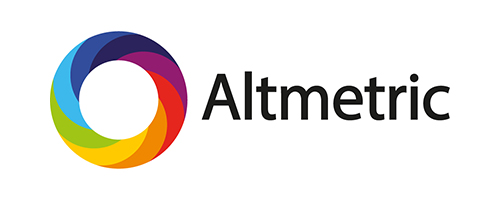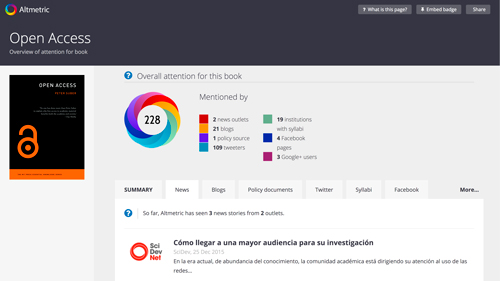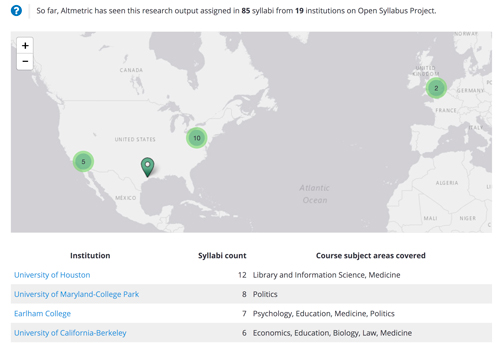Are your readers who you expect? Altmetric Badges for Books

For academic journal articles Altmetric badges are a widely used and well understood measurement of impact. Historically, due to both complexities in the data and differences in the way audiences engage with the content, it has been more difficult to provide the same kind of insights into the impact of books and book chapters.
These difficulties are a particular challenge for academic disciplines such as the arts, humanities and social sciences, where books make up a much larger part of scholarly output yet are often underrepresented in traditional impact measures. As funders, governmental research assessments, publishers and institutions come to expect academics to better evidence where and why their research has had an impact beyond the scholarly sphere (societal, economic or otherwise), it’s important that books aren’t left behind.
Now, Altmetric Badges for Books are on the same journey to becoming a broadly adopted indicator of engagement and dissemination. These dynamic visualizations offer book and chapter authors the insights that journals have benefitted from for years, but also offer some unique data points that can help authors and publishers trace reviews in popular media and see where (and how often!) a title is featured in academic syllabi.

For the first time, the badges enable book authors to easily see and showcase where their titles or chapters are being mentioned in mainstream media outlets, public policy documents, patents, social platforms, Wikipedia and other online community forums.
These conversations are happening in huge volumes - in the last week alone Altmetric has found over 500,000 online mentions of almost 10,000 books - and the activity is growing all the time. It’s not just the most recent publications that are getting mentioned now: Altmetric’s unique data also exposes the influence of older publications - helping publishers and authors to demonstrate their relevance years or months after publication.

For authors, the impact of their own work is probably of most interest. For publishers, a broader set of Altmetric data gathered across their titles can contribute to many aspects of acquisitions, commissioning, planning, marketing and sales.
One of the most interesting insights highlighted by Altmetric is that readers are not always who we expect them to be. A look through the data already collected by Altmetric Badges for Books reveals some interesting anomalies:
- A UK-based publisher or institution might be surprised to find that their books have been cited more in Swiss and US public policy than in UK public policy.
This insight might enable this publisher or research organization to tweak marketing and communication plans in these territories to capitalise on the affirmation of quality that mentions in policy documents can provide. Publishers may also want to review their commissioning strategy to build on the success of titles in these countries, offering follow up or companion titles that can attain a higher profile as they are building on previous success.
Impact isn’t only about numbers, understanding the type of impact a book has generated is also really important. Sometimes a high value, niche audience really matters in terms of demonstrating impact or understanding the influence of a publication. This is especially the case with policy makers, since a small number of readers can affect a society-wide change.
Policy makers do look to other countries to see what has been successful, so a clever marketing campaign exploring the success of policies to which their books contributed may enable this publisher to use these titles to enter new markets, or an institution to raise their profile amongst potential hires or in student recruitment.
- Monographs published by a primarily humanities-focused university press have been cited in 40 STM patents since 1994.
The patents market is not an obvious one for a humanities based publisher. Using this insight, a marketing team may wish to increase the profile of their brand among commercial research and development departments and corporate libraries.
A more detailed examination of the data may reveal themes that lead the publisher’s editorial department to repackage these works in a different way for this new market, or commission follow up work.
Both the examples above would be important knowledge for the authors of these works, who need to be able to highlight the impact of previous projects, in order to win funds and support for new work.
What’s required for tracking attention to a book or chapter?
The good news is Altmetric may have already found mentions of your work! For the tracking to work, 3 things are needed:
- A book or chapter hosted on a domain Altmetric tracks (such as https://mitpress.mit.edu/books)
- A unique identifier (such as an ISBN or DOI) associated with the publication
- Mentions in an attention source we track!
Get started
If you’re a publisher or institution who has yet to use Altmetric for Books, we hope the examples above have demonstrated how this new data can create insights of real value to your entire organization. All of the data can be accessed via the badges, or via the Books Index in the Altmetric Explorer platform.
Questions are welcome - our team would be happy to provide more information at info@altmetric.com.






